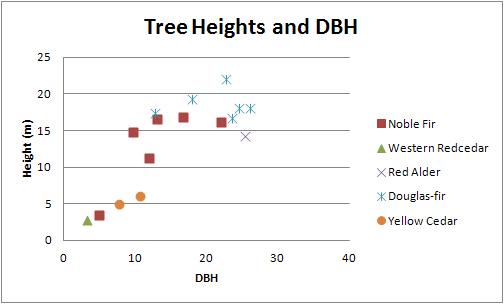CFS: Douglas-fir Plantation

History
In the late 1960's and 1970's, a Botany Professor at the University of British Columbia, Dr. Jack Maze, used this plot to grow various species of grass. These grasses were used for studies of floret and megagametophyte development. Along with his research, the grasses grown were also used for M.Sc. research by Lyle Mehlenbacher and Ph. D. research by Yee Kiew Kam.
Later, in the early 1980's, Jack Maze and Mishtu Banerjee planted the Douglas-fir for a joint project with UBC and CIP (a nursery in Saanich, BC that no longer exists). The yellow cedar planted immediately to the southeast formed the basis for Mishtu Banerjee's M.Sc. research which looked within and between-seedling variation as it was affected by position of cones in the trees.
On completion of these experiments, the plantations became overgrew with weeds. For the past 10 years the plantations have been maintained by the now retired forestry Professor,Dr. John Worrall.
General Site Information
Elevation: 70 m above sea level
Aspect: Southeast
Adjacency: The plantation resides beside agricultural crops, the First Nations hub, and a machinery access road.
Canopy Cover: 90 %
Major Tree Species by Volume: Noble fir (Bp)
Minor Tree Species by Volume: Douglas-fir (Fd)
Soil Profile

Forest Floor
Litter Layer: The depth is 0.03 m with loose structure. There is a very small presence of mycelia, fecal matter or roots within this layer.
Fermentation Layer: The depth is 0.03 m with loose structure. There is a very small presence of mycelia, fecal matter or roots in this layer.
Humus Layer: There is no obvious Humus layer to report.
Mineral Soil
Soil Order: Humo-ferric Podzol
SNR: Rich to Very Rich
| Horizon Type | Depth (m) | Colour | Texture | Course Frag. % (G/C/S) | Course Frag. Shape | Root Abundance/size | Structure Class | Structure Kind |
|---|---|---|---|---|---|---|---|---|
| Ah | 0.15 | 2.5Y 3/3 | Loamy sand | 10/1/0 | Sub-angular Blocky | Few/Medium | Fine | Granular |
| Bf | 0.64 | 10YR 4/6 | Sandy | 10/5/10 | Sub-angular Blocky | Plenty/Medium | N/A | Single-grain |
| C | 0.65+ | 2.5Y 5/3 | Loamy sand | 1/0/0 | Sub-angular Blocky | None | Massive | Cemented |
Understory Vegetation

Ground vegetation that reaches the lowest level of the tree canopy consists of red elderberry. The dense overstory canopy shades out most understory species, so the understory is sparse. As well, the lowest branches of the Douglas-fir plantation are high because of self-shading. The ground cover includes native and non-native shade-tolerant vegetation including buttercup, 3-leaved bramble, holly, and sword fern.
Tree Layers


The overstory canopy consists of Douglas-fir with a crown closure of 91 %, leaving very few gaps for transmission of direct light to the understory. Bordering the plantation is a mix of conifers: Noble fir, yellow cedar and western redcedar. The single canopy of Douglas-fir a few dominant and supressed trees, and lots of co-dominant and intermediate crown class trees. The dominant trees have an average height of 19.3 m and an average DBH of 24.2, while the suppressed trees have a height average of 16.7 m and a DBH of 18.2.
Wildlife Trees and Large Woody Debris
There are some dead noble fir, yellow cedar, and Douglas-fir trees in this area that have died due to inter-tree competition and are still standing (Wildlife Tree Class 3 - twigs or needles missing but intact bark and wood). Some trees have been felled and removed in thinning operations. There is no large woody debris.
Wildlife
American robins enjoy the cover provided by these trees for nesting and roosting. Click the Play button below to hear what robins sound like.
Critical Thinking
What do you see when you first look at this stand? This area of trees is a great example of a dense, even-aged plantation.
How are the trees spaced? Do they have similar diameters? Where does the foliage start?
These are good indicators for high competition for light in this stand.
The lower branches have been shaded out as the trees add new foliage in the upper crown. This leads to skinny trees because they are not producing enough photosynthates to add much diameter growth. Watch out for branch stubs poking you as you walk through this stand.
Trees are not the only thing alive in this stand. Some of the stumps are too. Take a look at this living stump. Where does it get the energy it needs for growth?

Put your manager's cap on and think of the products that could be made with the trees here? Will these trees make good lumber, telephone poles, veneer, pulp?
How important is this stand for wildlife habitat? What habitat features are missing?
If the stand is harvested, what would be a good prescription? Could there be another plantation, a garden or a hedgerow? Keep in mind that the adjacent agriculture fields will be shaded as these trees grow taller. Also think about how removing this stand will affect wind flow, and views within the farm!
